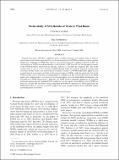| dc.contributor.author | Tziperman, Eli | |
| dc.contributor.author | Gebbie, Geoffrey | |
| dc.date.accessioned | 2010-03-05T15:32:34Z | |
| dc.date.available | 2010-03-05T15:32:34Z | |
| dc.date.issued | 2009-01 | |
| dc.date.submitted | 2008-03 | |
| dc.identifier.issn | 1520-0442 | |
| dc.identifier.uri | http://hdl.handle.net/1721.1/52334 | |
| dc.description.abstract | Westerly wind bursts (WWBs), a significant player in ENSO dynamics, are modeled using an observationally motivated statistical approach that relates the characteristics of WWBs to the large-scale sea surface temperature. Although the WWB wind stress at a given location may be a nonlinear function of SST, the characteristics of WWBs are well described as a linear function of SST. Over 50% of the interannual variance in the WWB likelihood, zonal location, duration, and fetch is explained by changes in SST. The model captures what is seen in a 17-yr record of satellite-derived winds: the eastward migration and increased occurrence of wind bursts as the western Pacific warm pool extends. The WWB model shows significant skill in predicting the interannual variability of the characteristics of WWBs, while the prediction skill of the WWB seasonal cycle is limited by the record length of available data. The novel formulation of the WWB model can be implemented in a stochastic or deterministic mode, where the deterministic mode predicts the ensemble-mean WWB characteristics. Therefore, the WWB model is especially appropriate for ensemble prediction experiments with existing ENSO models that are not capable of simulating realistic WWBs on their own. Should only the slowly varying component of WWBs be important for ENSO prediction, this WWB model allows a shortcut to directly compute the slowly varying ensemble-mean wind field without performing many realizations. | en |
| dc.description.sponsorship | McDonnell Foundation | en |
| dc.description.sponsorship | National Aeronautics and Space Administration | en |
| dc.description.sponsorship | National Science Foundation Climate Dynamics Program (Grant ATM-0351123) | en |
| dc.language.iso | en_US | |
| dc.publisher | American Meteorological Society | en |
| dc.relation.isversionof | http://dx.doi.org/10.1175/2009JCLI2516.1 | en |
| dc.rights | Article is made available in accordance with the publisher's policy and may be subject to US copyright law. Please refer to the publisher's site for terms of use. | en |
| dc.source | American Meteorological Society | en |
| dc.title | Predictability of SST-Modulated Westerly Wind Bursts | en |
| dc.type | Article | en |
| dc.identifier.citation | Gebbie, Geoffrey, and Eli Tziperman. “Predictability of SST-Modulated Westerly Wind Bursts.” Journal of Climate (2009): 3894-3909. © 2010 American Meteorological Society | en |
| dc.contributor.department | Massachusetts Institute of Technology. Department of Earth, Atmospheric, and Planetary Sciences | |
| dc.contributor.approver | Gebbie, Geoffrey | |
| dc.contributor.mitauthor | Gebbie, Geoffrey | |
| dc.relation.journal | Journal of Climate | en |
| dc.eprint.version | Final published version | en |
| dc.type.uri | http://purl.org/eprint/type/JournalArticle | en |
| eprint.status | http://purl.org/eprint/status/PeerReviewed | en |
| dspace.orderedauthors | Gebbie, Geoffrey; Tziperman, Eli | en |
| mit.license | PUBLISHER_POLICY | en |
| mit.metadata.status | Complete | |
